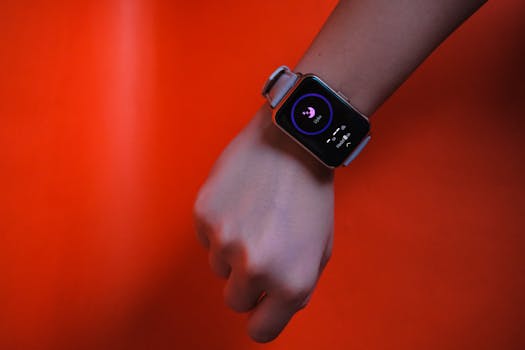
“
Smart Fabrics: The Next Frontier in Wearable Technology for 2026
Introduction to Smart Fabrics

Smart fabrics, also known as wearable technology, are fabrics that have been integrated with technology to provide various functions such as monitoring vital signs, tracking fitness, and enhancing safety. Smart Fabrics are the next frontier in wearable technology, and they’re changing the way we interact with our clothing and accessories. With the ability to monitor our health, track our fitness, and even charge our devices, smart fabrics are poised to revolutionize the fashion industry.
Types of Smart Fabrics

There are several types of smart fabrics, each with its own unique features and benefits. Some of the most common types of smart fabrics include:
- Conductive fabrics: These fabrics are made with conductive materials such as copper or silver and can be used to create wearable devices such as fitness trackers and smartwatches.
- Thermoelectric fabrics: These fabrics can generate heat or coolness and can be used to create clothing that can regulate body temperature.
- Photovoltaic fabrics: These fabrics can generate electricity from sunlight and can be used to charge devices such as smartphones and laptops.
- Sensing fabrics: These fabrics can detect changes in the environment such as temperature, humidity, and light and can be used to create clothing that can respond to these changes.
Applications of Smart Fabrics

Smart fabrics have a wide range of applications, from healthcare and fitness to fashion and textiles. Some of the most promising applications of smart fabrics include:
- Health monitoring: Smart fabrics can be used to create clothing that can monitor vital signs such as heart rate, blood pressure, and body temperature.
- Fitness tracking: Smart fabrics can be used to create clothing that can track fitness metrics such as steps taken, distance traveled, and calories burned.
- Safety enhancement: Smart fabrics can be used to create clothing that can enhance safety such as reflective clothing, flame-resistant clothing, and clothing that can detect falls.
- Fashion and textiles: Smart fabrics can be used to create clothing that can change color, shape, and texture in response to environmental changes.
Conclusion

In conclusion, smart fabrics are the next frontier in wearable technology, and they’re changing the way we interact with our clothing and accessories. With their ability to monitor our health, track our fitness, and enhance our safety, smart fabrics are poised to revolutionize the fashion industry. As technology continues to advance, we can expect to see even more innovative applications of smart fabrics in the future.
Future of Smart Fabrics

The future of smart fabrics is exciting and full of possibilities. With the advancement of technology, we can expect to see even more innovative applications of smart fabrics in the future. Some of the potential future applications of smart fabrics include:
- Integration with artificial intelligence: Smart fabrics could be integrated with artificial intelligence to create clothing that can learn and adapt to our needs.
- Biodegradable materials: Smart fabrics could be made from biodegradable materials that can reduce waste and minimize environmental impact.
- 3D printing: Smart fabrics could be created using 3D printing technology, allowing for complex designs and structures that cannot be produced using traditional manufacturing methods.
Impact of Smart Fabrics on the Fashion Industry

The impact of smart fabrics on the fashion industry will be significant. With the ability to create clothing that can monitor our health, track our fitness, and enhance our safety, smart fabrics will change the way we design, produce, and consume clothing. Some of the potential impacts of smart fabrics on the fashion industry include:
- Increased focus on sustainability: Smart fabrics could lead to a greater focus on sustainability in the fashion industry, as companies seek to reduce waste and minimize environmental impact.
- New business models: Smart fabrics could enable new business models, such as clothing rental services or subscription-based services for smart clothing.
- Changes in consumer behavior: Smart fabrics could change the way consumers interact with clothing, with a greater emphasis on functionality and performance rather than just aesthetics.
Challenges and Limitations of Smart Fabrics

While smart fabrics have the potential to revolutionize the fashion industry, there are also challenges and limitations to their adoption. Some of the challenges and limitations of smart fabrics include:
- Cost: Smart fabrics are currently more expensive than traditional fabrics, which could limit their adoption.
- Comfort: Smart fabrics may not be as comfortable as traditional fabrics, which could affect their wearability.
- Durability: Smart fabrics may not be as durable as traditional fabrics, which could affect their lifespan.
Conclusion

In conclusion, smart fabrics are the next frontier in wearable technology, and they’re changing the way we interact with our clothing and accessories. With their ability to monitor our health, track our fitness, and enhance our safety, smart fabrics are poised to revolutionize the fashion industry. While there are challenges and limitations to their adoption, the potential benefits of smart fabrics make them an exciting and innovative technology to watch in the future.
Recommendations for Future Research

Based on the current state of smart fabrics, there are several areas that require further research and development. Some of the recommendations for future research include:
- Improving the comfort and durability of smart fabrics
- Reducing the cost of smart fabrics
- Developing new applications for smart fabrics
- Investigating the potential environmental impact of smart fabrics
Conclusion

In conclusion, smart fabrics are a rapidly evolving field that has the potential to revolutionize the fashion industry. With their ability to monitor our health, track our fitness, and enhance our safety, smart fabrics are an exciting and innovative technology to watch in the future. As research and development continue to advance, we can expect to see even more innovative applications of smart fabrics in the years to come.
Smart Fabrics and the Internet of Things

Smart fabrics are also closely related to the Internet of Things (IoT), which refers to the network of physical devices, vehicles, home appliances, and other items that are embedded with sensors, software, and connectivity, allowing them to collect and exchange data. Smart fabrics can be integrated with IoT devices to create a more connected and interactive experience.
Smart Fabrics and Artificial Intelligence

Smart fabrics can also be integrated with artificial intelligence (AI) to create clothing that can learn and adapt to our needs. For example, a smart fabric could be designed to adjust its temperature or texture based on the wearer’s preferences or environmental conditions.
Smart Fabrics and Sustainability

Smart fabrics can also have a positive impact on sustainability. For example, smart fabrics can be designed to reduce waste, minimize environmental impact, and promote recycling. Additionally, smart fabrics can be used to create clothing that can be worn multiple times, reducing the need for frequent purchases and waste.
Conclusion

In conclusion, smart fabrics are a rapidly evolving field that has the potential to revolutionize the fashion industry. With their ability to monitor our health, track our fitness, and enhance our safety, smart fabrics are an exciting and innovative technology to watch in the future. As research and development continue to advance, we can expect to see even more innovative applications of smart fabrics in the years to come.
Final Thoughts

In final thoughts, smart fabrics are the next frontier in wearable technology, and they’re changing the way we interact with our clothing and accessories. With their ability to monitor our health, track our fitness, and enhance our safety, smart fabrics are poised to revolutionize the fashion industry. As technology continues to advance, we can expect to see even more innovative applications of smart fabrics in the future.




1 thought on “Smart Fabrics: The Next Frontier in Wearable Technology for 2026”
Comments are closed.